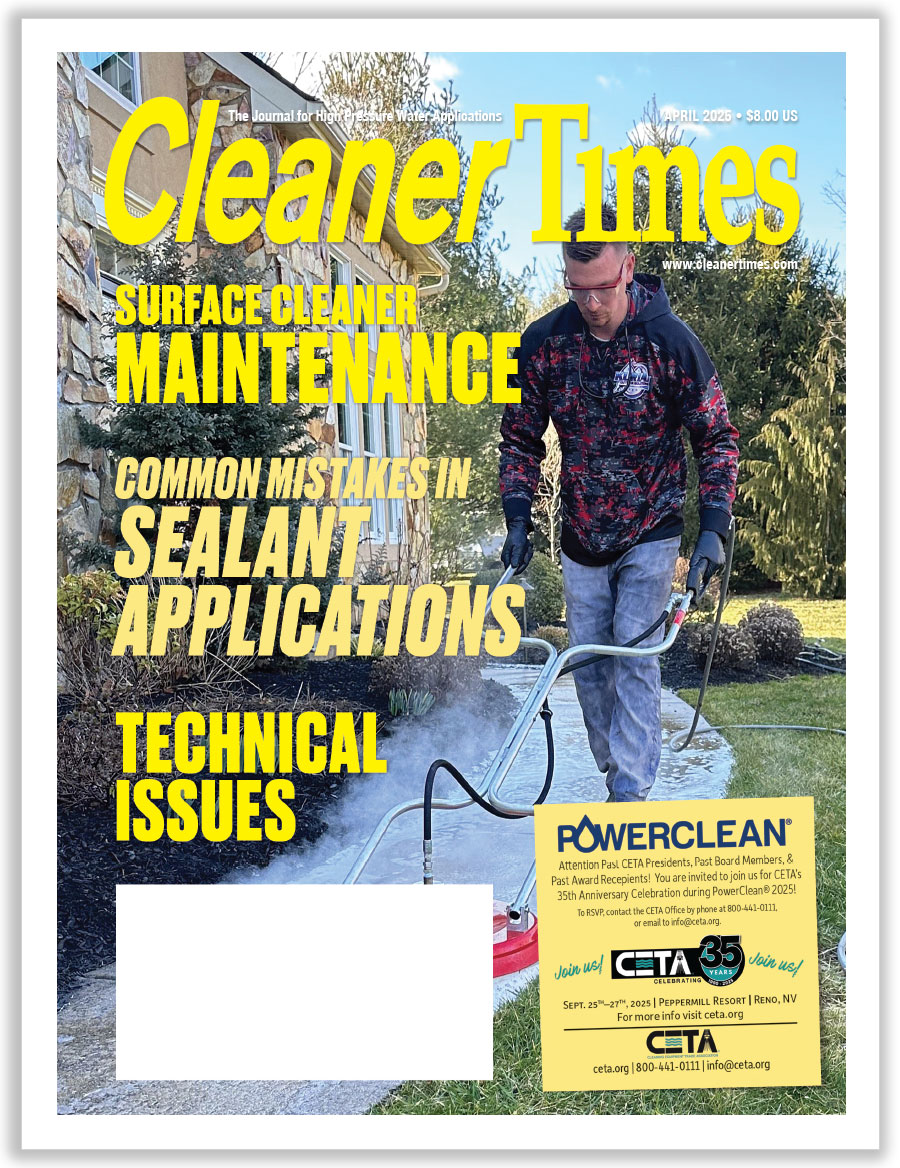
Obstacles to Getting the Job Done
By Diane M. Calabrese / Published July 2020

Road work. Thunder-storms. Blizzards. Chattering customers. Talkative coworkers. It’s easy to generate a list of obstacles to getting the job done, even without the ‘v’ word (virus). So, let’s take a short break from the v-intensity and focus on the day-in, day-out, routine obstacles.
Anything that hinders or impedes movement—literally or figuratively—is an obstacle. Misplaced keys to the truck are in the literal category. But just as real is a weariness that slows down thinking and causes every effort to take longer.
The leader of a large contracting company gets us started with examples from that work setting. “From a commercial perspective, the most challenging obstacle would be access to high profile or sensitive work areas,” says Ty Eubanks, CEO of South Shore Building Services Inc. in Anaheim, CA.
“Typically, pressure washing services represent challenges to pedestrian and vehicular traffic,” says Eubanks. “In addition to access challenges, there is the issue of being associated with a potential slip and fall complaint.”
Knowing what the obstacles to job completion are, of course, is just one half of the equation. The other is devising a way to deal with them.
“In order to avoid disruption of time and production, we send out service memos two weeks in advance to our customers,” explains Eubanks. “The memos communicate site-specific requirements and precautions.”
When the job commences, there is careful follow through. “Once on site, we start the high profile—most sensitive—surface locations as soon as possible to optimize production,” says Eubanks. “Slip and fall exposure is reduced by communicating surface conditions using a combination of ‘wet floor’ floor signs and/or delineated barricades.”
Follow-through continues when the cleaning is finished. “Following the service, excess standing water is floor squeegeed with cones left in place during the evaporation process,” explains Eubanks. “To further mitigate slip-and-fall occurrences, the customer is notified with the recommendation that floor mats be placed inside of access doors, particularly when floor types are susceptible to slippage, such as marble, tile, etc.”
We led this article with mention of too much talk as an obstacle to getting work done. The adage that actions speak louder than words is out there for a reason. Too much deliberation or just dithering on the part of employees can slow things down and, worse, lead to complications.
Every leader of a company aims to find the optimal balance between giving employees great autonomy and ensuring excellent results at worksites. Yet members of a team often need a little boost, specifically reminders about what it means to be accountable, as the flip side of being autonomous.
The time a business owner must invest in encouraging employees to focus, get it right the first time, and such is an obstacle to getting the job done. A strong intervention may be needed.
“The hustle and bustle of employees attempting to renegotiate the terms and conditions to complete the task at hand” can be an obstacle, explains Bill Sommers, president, Pressure Systems Industries Inc.-Mist Air in Phoenix, AZ. “This consumes valuable time commensurate to no actual invoicing time.”
How can such an obstacle be countered? “Bring the conversations to an end by cutting through the distracting discussion with explicit instructions,” says Sommers. “This only works when I am available on the spot to do my job.”
Sommers explains that many of the hindrances to job completion are intricately tied to the way people approach work and problems. “Every workday brings multiple obstacles to deal with,” he says. “I propose that this is an act of human conditions, which include wanting to have the correct response to the problem…”
Wanting to have the correct response is a good thing. Where things get off course is when, instead of making the effort to identify that response, an “oh-well-let’s-try-this” approach takes hold.
Too often, explains Sommers, team members “lack the knowledge because they would rather guess than take the time to find out the correct response from an experienced source.” And, what happens when something goes awry because they supposed instead of verified?
“Problems occur,” says Sommers. Indeed, his assessment ties us to a considerable body of research on an obstacle to getting a job done: the role of distraction.
For instance, employees who would prefer to toss around guesses on how to resolve an issue rather than find a tried-and-true method are at some level distracted. So, too, are employees, who fail to place cones or barriers. And so on.
Distraction
Draw apart. With attention diverted for any reason, the mind is distracted.
At the core of almost every obstacle to getting a job done is a distraction. Storms distract. New and soured love relationships distract. There’s no end to the list.
Not only do distractions correlate with obstacles to getting the job done, but they also make a workplace less safe. Lost productivity is a bad outcome. Injuries on the job are even worse outcomes.
SafeAtWorkCA.com, the website of the California State Compensation insurance fund, offers many informative articles about how to reduce workplace injuries, including how to reduce distractions. (Other states provide similar guidance.)
The big takeaway from a short primer on workplace distractions at www.safeatworkca.com/close-calls is that operating equipment should be an exclusive endeavor. It should not be done in combination with talking with a colleague, texting, or day dreaming. Moreover, any interruption to someone who is at a critical phase of a job or operating a machine poses a danger.
Consequences of disrupting the work of an equipment operator may be the riskiest, but they are not the only serious concerns. Those in office settings can be distracted by faxes, printers, conversations, etc.
The pinging alerts from text messages can become so frequent they fray nerves. Many people become inured to distracting sounds (a real, documented problem in hospitals when alarms become so frequent that they are “not heard”), but others find them a serious obstacle to clear thinking.
A lack of clear thinking leads to confusion. Confusion is a huge obstacle to getting a job done.
The Federal Aviation Administration (FAA) offers a fact sheet on reducing risk of distractions in conjunction with the general aviation (GA) community’s national #FlySafe campaign. See https://www.faa.gov/news/updates/?newsId=94945.
The tips provided are useful well beyond the cockpit. And many readers may think about adapting them in a safety session for team members. Some adapted nuggets follow.
Realize that there are interruptions and distractions over which we have no control, but control the controllable. For instance, when doing a procedural review or running through a safety checklist, do it when there is no or minimum distraction.
Know the critical junctures in any procedure and determine not to be disrupted. It may be starting an engine or covering utility outlets.
Communicate with team members in the clearest and most concise way. Avoid tangents, nostalgia for jobs gone good or bad, talk of weather…all those things are distractions.
Perhaps the most powerful statement on the fact sheet concerns conversation. “A powerful distractor” is the descriptor given for conversation. Just the act of talking with another person distracts. The act itself can be compounded by a discussion that veers into controversial topics.
If there is an interruption to a job, treat it as the distraction it is, advises the fact sheet. Recall what was being done before the interruption. Then, take the necessary steps to get refocused and continue the job at hand.
Obstacles may be divided into two broad categories: physical and social. The physical includes machinery failures and forces of nature. Social includes inattention to instructions and disregard for correct procedures. Yet, a machine failure may result because a team member did not follow proper guarding, storage, or maintenance recommendations, making the dichotomy complicated.
Except that it’s quite simple. By staying focused and committing to know and use best practices on every job, many obstacles disappear.
It’s also important that team members know what to do if a workplace hazard suddenly arises. If a contractor’s team discovers an active wasp nest on the side of a house being washed, their first object should be to remove the hazard, even if it requires a call to an exterminator. Similarly, lightning means a pause.
The wasp nest and lightning serve as two examples, chosen because they bring us to a final point. Most contractors have encountered both obstacles. Some may have tempted close calls by not eliminating the nest or waiting for the storm to pass.
Close calls come in all forms. For a distributor they might be a service representative sending a less-than-cordial email to a customer. For a manufacturer they might be trying to let a weakened belt run just a bit longer. Both are likely to create obstacles and highly avoidable ones.
Any kind of close call should be remembered, discussed, and used to promote hazard awareness and good business practices. The small stuff should never be an obstacle to getting the job done.






